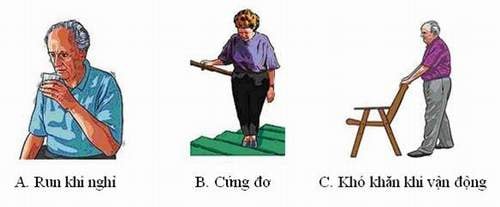Medicine for Parkinson's syndrome
Oriental medicine calls Parkinson's disease "tremor paralysis", a common chronic disease of the elderly, caused by degeneration of nervous tissue.
According to statistics, at the age of 60, the incidence is 1%, and at the age of 85 or older, about 2.6% of people have the disease. If not treated early, Parkinson's disease will progress over time and lead to many disorders that cause loss of labor and disability.
CausesParkinson's diseaseis due to cerebral arteriosclerosis and encephalitis. Cerebral arteriosclerosis usually appears at the age of 50 - 60, due to circulatory disorders causing cerebral ischemia, creating brain softening points in the gray matter structure of the midbrain. The disease progresses slowly. After encephalitis, it is often a late sequela of neuritis. Parkinson's symptoms appear a few months or a few years after encephalitis. Patients have the following typical symptoms:
 |
Tremor: reduced or absent during activity, only tremor when quiet; more tremor when tired or emotional, no tremor when sleeping. Tremors are often seen in the limbs, especially the two hands; sometimes tremor occurs in the two legs, head and jaw.
Muscle stiffness: often occurs during activity, disappears when completely at rest, often causing muscle stiffness at the base of the limbs.
Slow movements: the patient walks slowly and with difficulty; takes small steps, drags feet, leans forward, climbing stairs is easier than walking on flat ground; facial muscles move little as if sad, speaks slowly and in a monotonous voice, sometimes stutters, sentences are interrupted, voice is monotonous, does not change speed or pitch; writes shakily, sometimes cannot write, makes normal movements very difficult, when standing it is difficult to turn around. Facial expression is cold, eyes do not blink, forehead does not wrinkle, both head and eyes are almost motionless, only the eyeballs sometimes move but very little.
The following are remedies, massage and acupressure methods to treat Parkinson's disease. Patients need to choose and apply appropriately.
Location of acupuncture points: Amon: between the hairline at the back of the neck. An mien 1: midpoint of the wind and light points. An mien 2: midpoint of the phong tri and ec minh points. Khuc Tri: close the arm to the chest, the point is at the outer crease of the elbow. Hegu: at the highest point of the muscle when the thumb and index finger are closed, the point is in the middle of the space between the thumb and index finger. Sanyinjiao: from the highest convexity of the inner ankle up 3 inches, the concave area close to the posterior edge of the tibia. Zusanli: the depression below the lateral tubercle of the patella. |
Oral medication: Use one of the following:
Big Safflower Decoction with spices: Safflower 6g, Pinellia ternata 4g, Fresh ginger 4g, Scutellaria baicalensis 3g, Peony 3g, Jujube 3g, Polygala 3g, Rhubarb 3g, Magnolia officinalis 4g. Decoct and drink. Indicated for Parkinson's disease with symptoms: difficulty turning and changing direction when walking; prickling sensation in both legs when running, difficulty walking, body gradually leaning forward when walking; trembling fingers, difficulty writing; decreased memory; slow and clumsy movements, dry mouth, difficulty speaking, slurred speech.
Seven-ingredient descending decoction: 4g each of rehmannia glutinosa, peony root, ligusticum wallichii, angelica root, and uncaria rhizome; 2g of phellodendron bark, 4g of peach seed, 4g of peony bark, 2g of rhubarb, and 6g of dodder seed. Decoct and drink. Indications for Parkinson's disease: obese person, normal complexion, sometimes cramps in knees and tendons, especially when running, shaking of limbs; unstable body, swaying of legs and waist; defecation once every 3 days, slow and clumsy speech and actions, distention of abdomen, signs of blood stasis on both sides of navel; electrocardiogram shows myocardial obstruction, deep and strong pulse.
When you see some symptoms have decreased such as the hands and feet stop shaking, blood pressure returns to normal... but the legs are still weak and unable to walk normally, switch to the Uy Chung Phuong formula: 15g of angelica, 12g of rehmannia glutinosa, 9g of peony root, 9g of atractylodes macrocephala, 9g of achyranthes root, 9g of trichosanthes root, 6g of astragalus root, 6g of dodder seed, 3g of phellodendron bark, 3g of rhubarb. Boil and drink.
Massage and acupressure:
Use both hands with all five fingers to rub until warm, then massage the head, face, neck, and back of the neck. The fingers grip the hairpin tightly, gathering the hair at the roots. The fingers of both hands close together and rub up and down both sides of the carotid artery. The fingertips of both hands squeeze firmly on both sides of the sternocleidomastoid muscle from the nape of the neck down to the shoulder blades.
Next, press the following acupoints: amen, anmien 1, anmien 2, quchi, hopgu, tussanli, sanyinjiao. Effects: healthy brain, stable nerves, good sleep, normal functioning of the whole body, good blood circulation.
According to Traditional Medicine Practitioner Nguyen Minh - Health & Life






